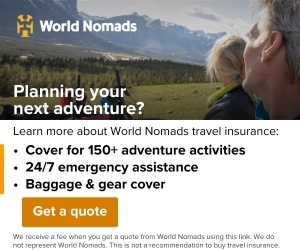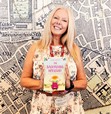Janice Horton's Blog, page 9
January 12, 2024
Taiwan – Taichung Feng Chia Night Market
Feng Chia Night Market – also known as Feng Jia Night Market – is certainly the most famous in Taichung.
Taichung is famous for night markets and street food.
And we just happen to love both and will actively seek out food markets!
Feng Chia Night Market is said to be the largest night market in Taiwan, with around 400 vendors offering their wares from 4pm until 2am every day.
Just before dark, we took the #79 public bus (using our Easy Card) from Taichung Station over to the Xitun District.
We got off at Feng Chai University stop and simply followed the crowds to the night market.
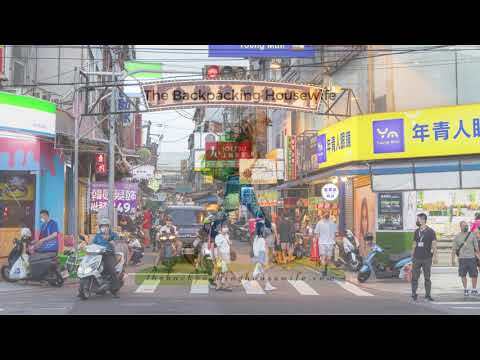
You enter the market under a neon lit sign and the atmosphere in the street is busy and colourful and vibrant.
And of course – amazingly fragrant – because the sounds and smells of food cooking was inciting and exciting.
We could hardly wait try the amazing variety of traditional Taiwanese street foods on offer.
Although, waiting is sometimes necessary as some of the most popular vendors already had long lines of people patiently waiting to buy food from them.
Which made us curious enough to join the queue in anticipation of something so good that it was worth the wait!
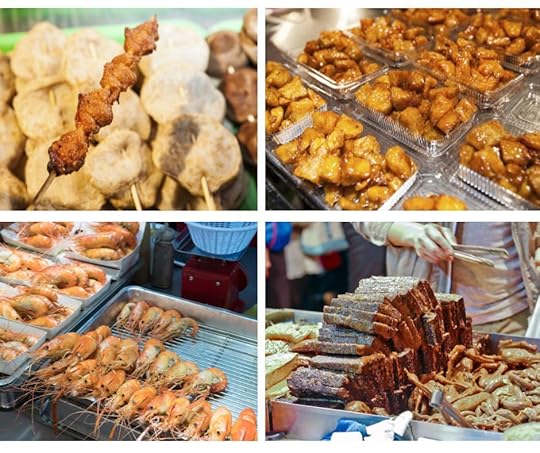
At Feng Chia Night Market there are so many different types and styles of foods and drinks to buy and try.
I noticed lots of fruit smoothies and the classic Taiwanese Bubble (Bobo) Tea on offer too!
We followed our noses and often stopped to try a morsel of something because it smelled amazing or it looked delicious.
Or, to simply watch in awe, at what the stallholder chef was expertly creating.
 WHAT FOODS DID WE TRY AT FENG CHIA NIGHT MARKET
WHAT FOODS DID WE TRY AT FENG CHIA NIGHT MARKETI absolutely LOVED the onion pancake (cong you bing) and while I was eating my pancake, the backpacking husband was waiting in line, for a Taiwanese style ‘hamburger’ or pork belly bun (gua bao).
He said the wait was well worth it.
Then we followed the crowds and and shuffled around eating delicious ‘QQ’ cheese bread sweet potato balls (di guaqiu) and we tried lots of different types of sweet and spicy Taiwanese sausages (xiang chang).
I think my favourite thing of all was the oyster omelette pancake (ke zi jian).
It was light and fresh and tasty with a salty sweet and spicy sauce. Absolutely delicious.
WHAT FOODS DID WE NOT TRY AT FENG CHIA NIGHT MARKETI know it’s incredibly popular all over Asia but I’m absolutely not into stinky tofu – it’s way too funky for me.
And, despite the protein benefits, we both avoided pork blood products.
Corn with red ants sprinkles and ditto any other kind of grilled insects or fried grubs.
No judgement here. Each to his own!
 Feng Chia Night Market
Feng Chia Night MarketFirst established in the 1960’s, the market hosts hundreds of food court stalls that line 1.5km of the streets in the same vicinity as Feng Chai University.
So, as you might imagine, the market is very popular with students looking for delicious, nutritious, and affordable eats.
But the authenticity, the bright lights and busy and vibrant atmosphere, the tempting culture of Taiwanese cuisine, also attracts the tourists, like us.
This makes Feng Chia Night Market a draw for 3,000 people a day (during non-holidays) and up to 10,000 per day during holidays. This equates to more than a bustling 10 million people every year.
Feng Chia Night Market was a delicious Highlight of Taichung City!
Check out all my posts on Taichung and our fabulous Taiwan 12 Day Travel Itinerary.
Next on our Taiwan adventure – we heading further south – to the port City of Kaohsiung!
Have you tried Taiwanese Food?
Do you have a favourite food market?
Let me know in the comments!
The post Taiwan – Taichung Feng Chia Night Market appeared first on The Backpacking Housewife.
January 11, 2024
Taiwan – The 921 Earthquake Museum
The 921 Earthquake Museum of Taiwan is in Taichung City, Taiwan.
The museum is dedicated to preserving the memory of the devastating earthquake that struck Taiwan on September 21, 1999, commonly referred to as the 921 Earthquake.
The 921 Earthquake measured 7.6 on the Richter scale.
We explored the museum as part of our three nights stay and Highlights of Taichung City.
Watch my introductory video!
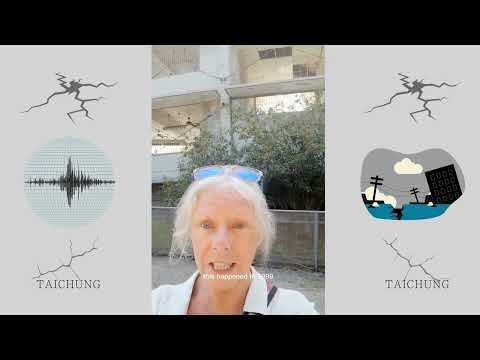
The 921 Earthquake Museum Taichung Taiwan
The earthquake claimed 2400 lives and many were injured and made homeless as houses and buildings all around the area collapsed.
The 921 Earthquake Museum and its exhibits are located at the site of the former Guangfu Junior High School, which collapsed during the earthquake.
What you see is a multi-story school building with its floors flat stacked and twisted on top of each other.
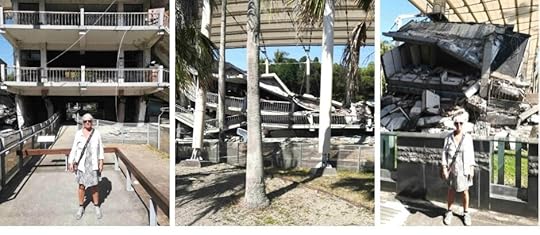

The school campus – notably the running track – has also been left exactly as it was found after the quake with its ruptured undulating tarmac and the eerily scar of its raised fault line. It’s a harrowing sight.
The school, the destruction, and the fault line has been preserved exactly as it was after the quake as a museum to raise awareness about the importance of public earthquake safety preparation.
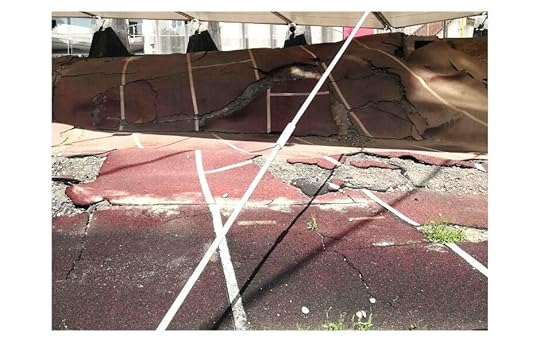
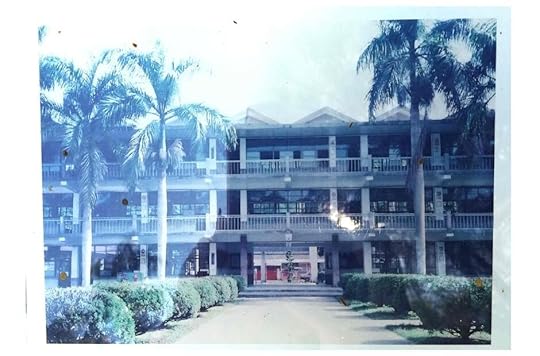 The School Before The EarthquakeDevelopment of earthquake proof design
The School Before The EarthquakeDevelopment of earthquake proof designTo educate people about developing evacuation plans, emergency exits, and the location of safe places within buildings, during an earthquake.
So, the underlying purpose of this museum is not only to serve as a memorial to those killed and injured, but to provide earthquake response education.
To show how this terrible disaster has since influenced the development of ground-breaking earthquake-proof building design systems.
Not just in Taiwan but throughout the world.
The Taiwan Tourism Website says: “The museum is a precious teaching material for natural science”.
So, although it might sound (and look) like a dark tourism experience – and therefore a little macabre – to spend a day at an earthquake museum and a site of disaster. I highly recommend it to you for your Taichung itinerary.
THE PRINCIPLES OF EARTHQUAKE PROOF BUILDINGSBecause earthquakes generate ground motion, buildings need to be able to withstand and absorb this motion, to prevent collapse or structural failure.
Therefore, earthquake-proof buildings, also known as earthquake-resistant or seismic-resistant structures, are designed and constructed to minimize damage and ensure the safety of occupants during seismic events.
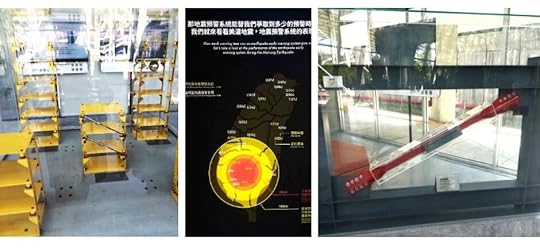 Seismic-resistant structures designed to minimize damage during seismic events
Seismic-resistant structures designed to minimize damage during seismic eventsThe museum has an Earthquake Engineering Education building on site.
The exhibits in the engineering building clearly demonstrate how it has been possible for geologists and technicians and engineers to further develop high-tech counter measures to the shaking and rocking movement of buildings during earthquakes.
I found it very interesting.
My backpacking husband, with his background in engineering, found it all fascinating.
It made us especially keen for our anticipated visit to the top of the 101 Tower in Taipei that – when it was built in 2004 – was the world’s tallest building.
It has been built with this new ‘earthquake proof’ technology installed.
And, the Taipei 101 Tower is the only public tower in the world, that has its earthquake proof counter measures and its massive gold painted pendulum ball dampening system on full display to the public!
This enormous steel sphere is suspended from the 92nd to the 88th floor and moves back and forth to reduce the motion of the building in strong gusts or earthquakes.
The pendulum swings in the opposite direction to the sway to dissipate the vibrational energy and to stabilise the tower.
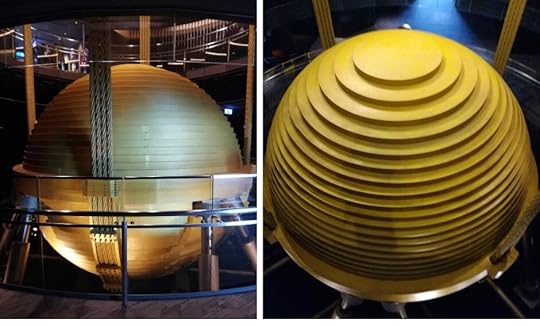 At the Taipei 101 Tower the massive gold painted pendulum ball is display to the public!
At the Taipei 101 Tower the massive gold painted pendulum ball is display to the public!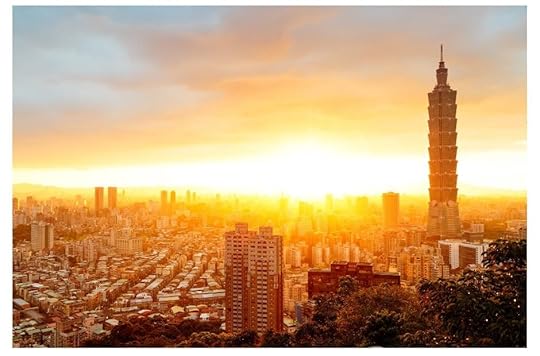 The Taipei 101 Tower in Taipei City
The Taipei 101 Tower in Taipei CityThis technology is now incorporated into many tall buildings of the world especially those in earthquake prone zones.
The earthquake museum also includes a ‘virtual earthquake’ experience where you can get to be in a room with a 7.2 earthquake simulation.
Having experience an earthquake tremor once myself (a 5.5 on the Richter Scale) in Honduras – I found it to be very realistic!
HOW TO GET TO THE 921 EARTHQUAKE MUSEUMWe took the public bus (paid using our Easy Card) which took about 40 mins to go from Central Taichung to the Earthquake Museum in the Wufeng District.
WHAT TO SEE AT THE 921 EARTHQUAKE MUSEUM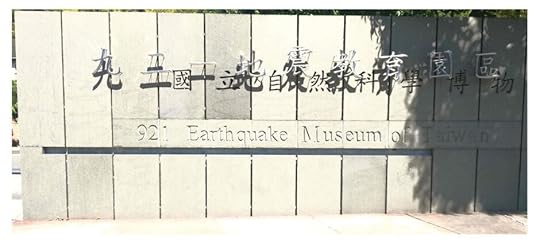
Memorial Hall: The museum features a memorial hall that pays tribute to the victims of the earthquake. It includes exhibits and displays documenting the events of the earthquake and its aftermath.
Educational Exhibits: The museum provides educational exhibits that explain the geological aspects of earthquakes, the causes of the 921 Earthquake, and the lessons learned in terms of disaster preparedness and response.
Outdoor Park: The museum incorporates the original ruins of the Guangfu Junior High School, which collapsed during the earthquake. Visitors can see the preserved wreckage as a reminder of the destructive power of earthquakes.
Interactive Displays: To enhance the learning experience, the museum offers interactive displays, multimedia presentations, and simulations to help visitors understand the science behind earthquakes and the importance of earthquake-resistant construction.
KEY FEATURES OF EARTHQUAKE-PROOF BUILDINGSFlexible Design and Materials: Engineers design earthquake-resistant buildings to be flexible and capable of absorbing and dissipating seismic energy.
Materials with high ductility and flexibility, such as steel and reinforced concrete, are commonly used in construction.
Base Isolation: Base isolation is a technique where the building’s foundation is decoupled from the ground motion using isolators. These isolators absorb and dissipate seismic energy, reducing the forces transmitted to the structure.
Common base isolation methods include using rubber bearings, sliding bearings, or other isolating devices.
Reinforced Concrete: Reinforced concrete structures are designed with steel reinforcing bars (rebar) to enhance the building’s strength and ductility.
Columns and beams are reinforced to improve their ability to withstand lateral forces and deform without collapsing.
Shear Walls and Bracing: Shear walls and bracing systems are employed to provide lateral stability to buildings. These elements help distribute seismic forces and prevent excessive swaying or tilting during an earthquake.
Bracing systems may include diagonal braces or shear walls made of reinforced concrete or steel.
Damping Systems: Damping systems are used to dissipate seismic energy and reduce building oscillations. This can include tuned mass dampers, viscous dampers, or other devices designed to absorb and dissipate energy.
Regular Inspection and Maintenance: Regular inspections and maintenance are crucial for ensuring the ongoing earthquake resistance of buildings.
Engineers and building owners should regularly assess the structural integrity of a building and address any issues promptly.
Seismic Building Codes: Many regions prone to earthquakes have established seismic building codes that mandate specific design and construction practices to enhance earthquake resistance.
These codes are developed based on geological data, historical earthquake records, and engineering research.
Advanced Simulation and Modelling: Engineers use advanced simulation and modelling tools to analyse how a building will respond to seismic forces. This helps in optimizing designs for earthquake resistance.
THE 921 EARTHQUAKE MUSEUM TAICHUNGThe 921 Earthquake Museum in Taichung Taiwan serves as an important reminder of the impact of natural disasters and the need for communities to be prepared for seismic events.
I would give our visit to the 921 Earthquake Museum top billing as a Highlight of our Taichung Itinerary.
I would also allow a good portion of your day to fully explore it all.
Would you like to experience this museum in Taichung?
Would you be fascinated to see the engineering exhibits?
Let me know in the comments!
The post Taiwan – The 921 Earthquake Museum appeared first on The Backpacking Housewife.
January 10, 2024
Taiwan – Original Bubble (Bobo) Tea Shop
Taichung City – Taiwan’s second largest city – is the home of the world-famous original Bubble Tea Shop!
Bubble Tea is also known as Bobo Tea or Pearl Tea and it has become a worldwide phenomenon.
The creation of bubble tea is credited to Lin Hsiu Hui, a teahouse owner in Taichung, Taiwan.
Bubble Tea is now so popular you’ll find Bubble Tea Shops all over the world.
But the original teahouse is Chun Shui Tang (春水堂) in downtown Taichung City!
Table Of Contents:
TAICHUNG IS THE HOME OF BUBBLE TEAWHAT EXACTLY IS BUBBLE TEA?TABIOCA PEARLSMILKING IT!STEEPED IN SUCCESSWHY IS BUBBLE TEA TRENDING?CHAI CHING!BUBBLES ON THE RISE?BUBBLE TEA KITSBUBBLE TEA RECIPEBUBBLE TEA FLAVOURS WHAT EXACTLY IS BUBBLE TEA?The story goes that Lin Hsiu Hui was inspired to add tapioca pearls to her iced tea after observing the popularity of Japanese desserts with small chewy pearls.
The term “bubble tea” is said to have originated from the bubbles that are created when the tea is shaken or stirred vigorously, producing a frothy layer on top.
A sign inside the shop properly explains the “unexpected” story of Bubble Tea in Taichung.
I particularly love that the clash and shaking of bubble tea “symbolizes the clash and fusion of the old and new cultures“.
In 1983, bubble black tea ended the dominance of traditional Chinese tea and has since taken the world by storm. Pearl milk tea is the result of unexpected combination of tapioca balls (pearls) and milk tea. The collision of ice cubes during the shaking process symbolizes the clash and fusion of the old and new cultures.
In the “Pearl Milk Tea DIY” section, you will use more than just your hands. While making the pearl tea, you will need to observe with your eyes and ears, smell the fragrance, taste the taste, get your whole body and mind in the process and of course, shake with your hands.
Chun Shui Tan Tea Shop
 Bubble Tea Menu
TABIOCA PEARLS
Bubble Tea Menu
TABIOCA PEARLS
The original bubble tea recipe consisted of black tea, condensed milk, syrup, and large tapioca pearls.
Its unique combination of flavours, textures, and the fun element of chewing on tapioca pearls, has contributed to its widespread appeal.
According to the Oxford Learning Dictionary – Bubble Tea (noun) is a Taiwanese cold drink made with tea, sweetened milk or other flavourings, and balls or ‘pearls’ of tapioca.
Which also explains why is sometimes known as Pearl Tea.
Wikipedia explains Bubble Tea as: also known as pearl milk tea, bubble milk tea, tapioca milk tea, boba tea, or boba – is a tea-based drink that originated in Taiwan in the early 1980s.
I’d actually never tried bubble tea myself, at this point in time.
But from travelling extensively, I can say I’d absolutely heard of it.
 MILKING IT!
MILKING IT!
Not only has bubble tea gripped countries throughout the whole of Asia but it has since become a worldwide obsession – not to mention a billion-dollar industry.
And to think that it all began here in Taichung City at the Chun Shui Tan Tea Shop.
I couldn’t pass up the opportunity to go to the tea shop where it was invented and try it from the original source!
My verdict?
Well, you’ll have to watch my video!

The Original Bubble Tea Shop in Taichung Taiwan STEEPED IN SUCCESS
In the 1990s, bubble tea started to make its way to other Asian countries and later to North America.
Its popularity continued to grow globally, and the drink underwent various adaptations and innovations, with different flavours, toppings, and types of tea being introduced.
Today, bubble tea is enjoyed by people all over the world, and it has become a symbol of Taiwanese culinary culture.
The success of bubble tea has also led to the establishment of countless bubble tea shops globally, offering a wide range of variations to cater to diverse tastes.
WHY IS BUBBLE TEA TRENDING?CoCo Fresh Tea & Juice – the world’s largest bubble tea chain, says: “The visually appealing nature of bubble tea and sharing these experiences on social media has contributed to bubble tea’s popularity, making it a sought-after beverage.”
CHAI CHING! Bobo Tea is a billion dollar industry!
Bobo Tea is a billion dollar industry!World Tea News reports – and I quote: “Globally, the bubble tea market has grown to be a multibillion-dollar business, and the market is expected to increase as a result of factors such as rising consumer demand, new product development, globalization, and the growing interest in Asian food and drinks”.
1999ShareTea.Com reports – and I quote: “the bubble tea market has reached a value of as much as $2.4 billion. Moreover, all indications are that the market will reach $3.6 billion by 2028”.
BUBBLES ON THE RISE?TheHustle.Co tells us – and I quote (loving the brewing and popping references here!): “Bubble tea is brewing up serious profits in the US and has been the hottest tea trend in America over the last decade. This is one craze that doesn’t appear to be at risk of popping anytime soon.”
BUBBLE TEA KITS CLICK TO SEE THIS KIT ON AMAZON
CLICK TO SEE THIS KIT ON AMAZONAnd, there’s no need to rush to Google ‘a bubble tea shop near me’ because you can now make Bubble Tea at home using shop bought Bubble Tea Kits. Yay!
Please note my link to this kit (see above) on Amazon Dotcom is via an affiliate link which means if you click the link and make a purchase I will receive a small commission at no extra charge to you.
BUBBLE TEA RECIPEIf you don’t want to make your bubble tea from a kit then these are the ingredients and methods in making your own bubble tea.
Base Tea: Bubble tea typically starts with a base tea, which can be black tea, green tea, oolong tea, or other flavoured teas.
The choice of tea can affect the overall taste of the drink.
Milk: Many variations of bubble tea include milk, which adds creaminess to the beverage.
Common milk options include regular milk, condensed milk, evaporated milk, or non-dairy alternatives like almond milk and soy milk.
Sweetener: Sweeteners are often added to bubble tea to enhance its flavour. Sugar syrup, honey, or other sweeteners may be used.
The level of sweetness can usually be customized to suit individual preferences.
Tapioca Pearls (Boba): One of the defining features of bubble tea is the addition of chewy tapioca pearls, often referred to as boba.
These are small, black, spherical balls made from tapioca starch.
They are usually cooked until they achieve a chewy consistency and are added to the bottom of the drink.
BUBBLE TEA FLAVOURS Pearl Tea in a variety of flavours
Pearl Tea in a variety of flavoursPopular Flavours: Bubble tea comes in a wide variety of flavours to suit different tastes include classic milk tea, taro, matcha, fruit teas, and more.
The versatility of bubble tea has led to the creation of countless creative and unique flavour combinations.
In addition to tapioca pearls, bubble tea can include various toppings such as fruit jellies, puddings, aloe vera cubes, or even ice cream.
These toppings add additional textures and flavours to the drink.
Shaking or Stirring: After the ingredients are combined, the drink is often shaken or stirred vigorously to create bubbles and froth, giving it the characteristic “bubble” name.
Cup and Straw: Bubble tea is typically served in a plastic or glass cup with a sealed lid and a wide straw. The straw is designed to be large enough to allow the tapioca pearls to be sucked up along with the liquid.
If you are visiting Taiwan and heading down to Explore Taichung, I recommend making a bubble tea pilgrimage to the original tea shop of Chun Shui Tang (春水堂) in Taichung City.
 Bubble Tea – A Trending Craze!
Bubble Tea – A Trending Craze!Have you ever tried the iconic beverage ‘Bubble Tea’?
I hope you enjoyed this article on Bubble Tea!
Let me know in the comments.
 CLICK THE IMAGE FOR MY 12 DAY TAIWAN ITINERARY!
CLICK THE IMAGE FOR MY 12 DAY TAIWAN ITINERARY!The post Taiwan – Original Bubble (Bobo) Tea Shop appeared first on The Backpacking Housewife.
January 8, 2024
Taiwan – Taichung Park
Taichung Park (also known as Chungshan Park) is a historic urban park located in the heart of Taichung City, Taiwan.
It is the oldest park in Taiwan and known for its scenic beauty, cultural significance, and historical value.
The backpacking husband and I stayed for three nights in Taichung at (affiliate link) The Holiday Inn Express hotel opposite Taichung Park.
Even though Taipei Taoyuan International Airport had been our gateway to Taiwan – our 12 Day Itinerary in Taiwan would begin in the mid-point city of Taichung.
From Taichung City we planned to venture further south to the port City of Kaohsiung before taking the THSR Bullet Train all the way north back to Taipei in time for the Taiwan Lantern Festival!
After breakfast on our first morning in Taichung, we took a walk around the park.
Even though it was still early springtime, it was warm and sunny, and very pleasant.
Watch my first day in Taiwan video!

Take a walk with me around the park
The park reflects a combination of traditional Chinese and Japanese garden design elements in its layout with a large central Sun Moon Lake, three picturesque pavilions, bridges, and walking paths.
The area covers approximately ten acres of beautiful landscaping.

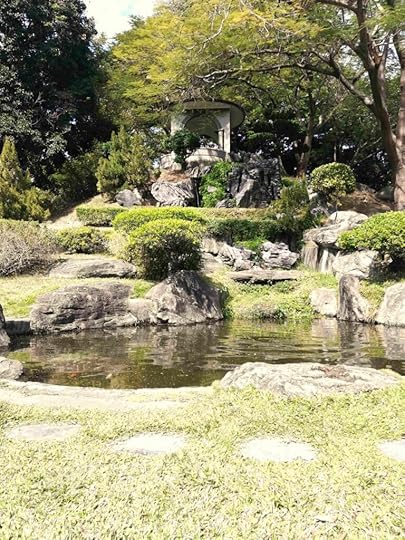
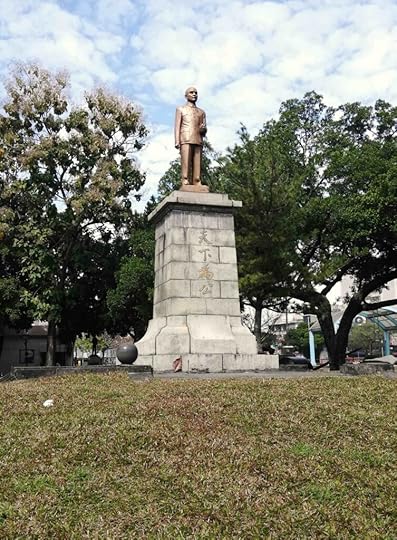
Taichung Central Park offers the visitor landmark structures, lots of flowers and plants, tall bamboo plantings, ancient trees, and also blossoming cherry trees.
All creating a natural oasis and peaceful escape from the bustling city life.
A perfect place for people to gather and families to picnic and children to play.
Or perhaps to practice yoga or taiichi or to row a boat on the lake.
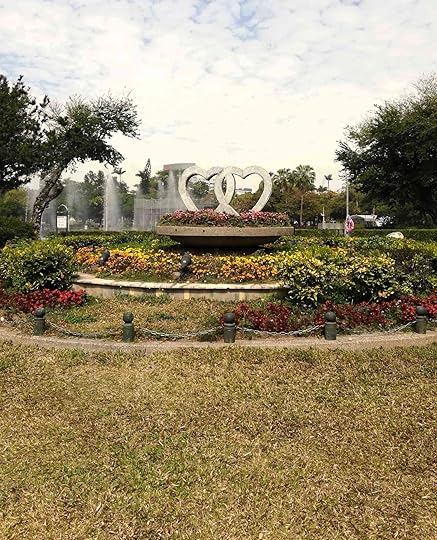 Beautiful Taichung ParkTHE PARK PAVILIONS
Beautiful Taichung ParkTHE PARK PAVILIONS Taichung Park Pavilion and Bridge
Taichung Park Pavilion and BridgeNotable structures within the park are the Wisteria Pavilion and the iconic Pavilion of the Holy Mother also known as the “Chung-Shiao Pavilion.”
This two-story building is situated on an island in the middle of the pond and is connected to the mainland by a zigzag bridge.
The Yu Lu Pavilion has an interesting and lovely story connected to the Japanese imperial family and the Taiwan Railway.
HISTORY OF TAICHUNG PARK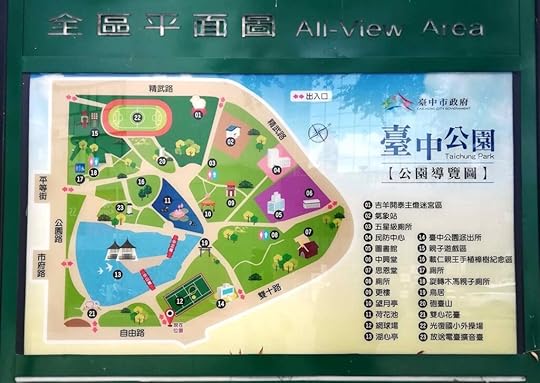 Taichung Park Map
Taichung Park MapI’m quoting this story for you from an information plaque on display in the park:
Taichung Park was established in 1903 and initially only a simple structure.
In 1908, the park was chosen by the Taiwan Governor General Office as the venue for holding the inauguration of the Taiwan Railway, where a member of the Japanese imperial family, Kotohito Shinnou honourably attended to host the opening on October 24th.
For this, the Taichung local authority thereby renovated the entire park and built the Mid-Lake Pavilion on sun-moon pond as a rest area for Kotohito Shinnou.
The pavilion has since become a famous Taichung landmark.
The turret in the park was originally built in the mansion of the Taichung financial governor Luan-Chi Wu in the 1880s.
When the mansion was demolished due to road construction in the 1980s, the Taichung City Government moved the turret to the north side of the park.
The Wangyue Pavilion was formerly located on the main northern gate of the Taichung City.
The two gun platforms on the fort of Eastern Dadun Hill were built by commander Ting-Chen Lan during the Ching Dynasty, which is how Taichung obtained its old name.
Dadun Street (literally means: street with big gun platforms).
In addition, there are a number of historical and cultural relics, amongst the ancient trees in the park.
The Park has become a place that Taichung citizens cherish as it accompanies their growth and life experiences.
THE SPIRITED GOAT MONUMENT The Spirited Goat Monument
The Spirited Goat MonumentThroughout the year, various cultural events, performances, and festivals take place within the park, attracting locals and tourists alike.
One such festival, The Taiwan Lantern Festival of 2003, took place in the park and it was celebrated as the most well-attended lantern festival to date.
This was of great interest to me because, in just a few days’ time, we were going to be in Taiwan for the Lantern Festival being held in Taipei for the first time in 23 years. This year’s festival was to celebrate The Year of The Rabbit.
But, back in 2003, it was held in Taichung in ‘Guei Wei’ or The Year of The Goat.
The huge ‘Spirited Goat and his family’ monument in the park commemorates this successful achievement for Taichung in 2003.
 A spirited ram, a ewe, and a suckling lamb, upon a pedestal of Yushan Mountain
A spirited ram, a ewe, and a suckling lamb, upon a pedestal of Yushan MountainThe information below – from a plaque in the park – explains the story:
The 2003 Lantern Festival was held from February 15th – 23rd in Taichung City for the first time, with the main lantern being placed in People’s Square.
Then, it moved to Taichung Park in the same year Jun after being adopted by the Taichung City Government.
Figuring a spirited ram, a ewe with loving kindness, and a suckling lamb upon a pedestal shaped as Yushan Mountain.
The main lantern symbolises a family in harmony and has the Chinese connotation that the three goats will bring auspicious beginning of a New Year and a surge of good luck to the country.
Up to 6 million people visited during the exhibition period that’s the highest amount ever.
The inscription stands as a memorial to the records.
Taichung City Government June 2003.
HOW TO GET TO TAICHUNG PARK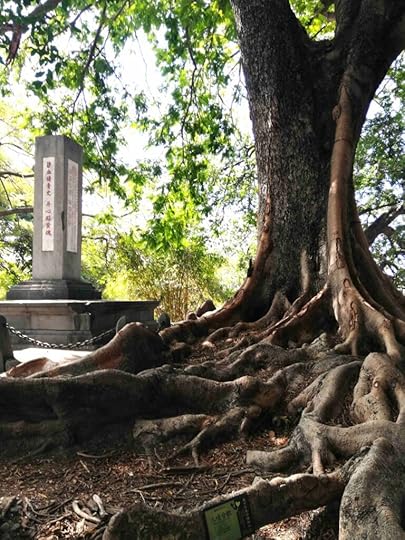
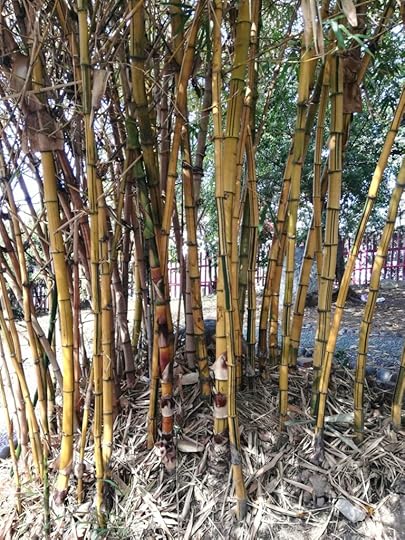
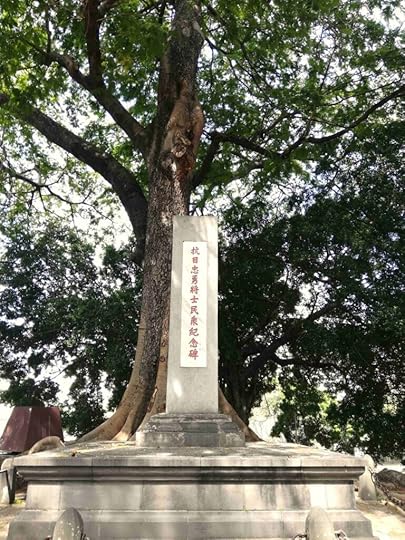
Located in the downtown area of Taichung City, the park is easily accessible by public transportation, including buses and the Taichung MRT system.
If you are planning a trip to Taiwan and you are heading to explore the mid-point City of Taichung, I would recommend a lovely walk around this lovely city centre park.
We stayed for three nights in Taichung at (affiliate link) The Holiday Inn Express hotel opposite the park.
You might like to see my post Highlights of Taichung City


The post Taiwan – Taichung Park appeared first on The Backpacking Housewife.
January 7, 2024
Taiwan: Highlights of Taichung City
Waking up in Taichung City after a great night’s sleep – all the travel fatigue and exhaustion from the previous day of flight delays had melted away – and I leaped out of bed in excitement to look out of the window and see Taichung City all around.
Good morning Taiwan!
Taiwan’s International Airport had been our gateway into Taiwan but Taichung – the second largest city in Taiwan – was our first introduction to this vibrant, thriving, and colourful country that had long been on our travel wish list!

Good morning Taiwan!
TABLE OF CONTENTS
HIGHLIGHTS OF TAICHUNG CITYOUR 12 DAY TAIWAN ITINERARYHIGHLIGHTS OF TAICHUNG CITYWHAT TO DO IN TAICHUNGTAICHUNG PARK:BUBBLE TEA:921 EARTHQUAKE MUSEUM:TAICHUNG FOOD SCENE:FENG CHIA NIGHT MARKET: OUR 12 DAY TAIWAN ITINERARYWe’d decided that on our arrival in Taiwan, our 12-day Itinerary would take us immediately out of the capital city of Taipei, to travel southbound along the western coast to the island’s mid-point City of Taichung.
We would be using the Taiwan High Speed Rail (THSR) ‘bullet train’.
We planned to explore Taichung for 3 days then continue south, once again travelling by THSR to the port city of Kaohsiung, for a further 3 day stay.
Then, returning to Taipei on the whole THSR route northbound, to arrive back in time for the Lantern Festival.
The Taiwan Lantern Festival was being hosted in Taipei for the first time in 23 years!
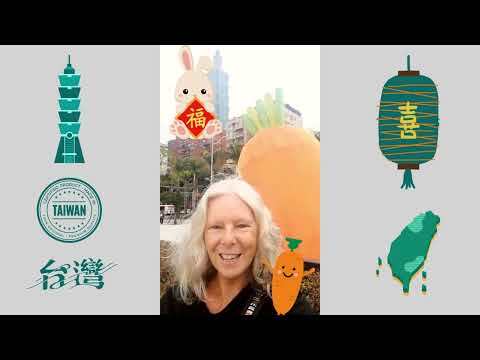
Taiwan – Our Fabulous 12-day Itinerary HIGHLIGHTS OF TAICHUNG CITY
The historic city of Taichung is centrally and conveniently located on the west coast of Taiwan.
Typically, Taichung is known for its manufacturing industry.
When I was a child growing up in the UK, I was very familiar with most of my toys being ‘Made in Taiwan’.
So, I certainly knew something about Taiwan (that it makes things) before I ever knew where it was in the world.
But, as well as being known to produce precision instruments and textiles, did you know that Taichung plays a significant role in the fabrication of bicycles?
It is considered one of the world’s major bicycle manufacturing hubs.
Taichung is also a city of ancient culture and modern art, with its combination of centuries-old shrines, cosmopolitan museums and art galleries – and perhaps most famously of all – its tea shops.
Taichung is the birthplace of the world-famous beverage Bubble Tea – also known as Bobo Tea or Pearl Tea – a tea drinking trend that has become a phenomenon firstly in Asia and now all over the world.
More Bubble Tea (with my video) later in this post!
WHAT TO DO IN TAICHUNG TAICHUNG PARK:The backpacking husband and I stayed for three nights in Taichung located in the Central District at (affiliate link) The Holiday Inn Express hotel opposite Taichung Park. The hotel is within easy reach of the train station and the bus terminal.
After breakfast on our first morning, we took a walk around the park.
It was wonderful to feel warm for our walk even though we were visiting in early springtime.
Taichung benefits from a mild year-round climate with warm winters and humid summers and average temperatures of 22.4 Deg C (72.F).
Taichung Park (also known as Chungshan Park) is the oldest park in the city (built in 1903).
The park covers an area of ten acres and is popular with locals for walks, exercising, family picnics, and as a meeting place for conversations and games.
It has an artificial lake, a bridge, a pavilion, ancient trees and expanses of tended green parkland, and meandering pathways.
It’s an oasis of calm in the heart of this busy city.
And a perfect place to practice yoga or your Taichi or to row a boat on the lake.

A walk around Taichung ParkBUBBLE TEA:
Have you ever tried the iconic beverage ‘Bubble Tea’?
According to the Oxford Learning Dictionary: Bubble Tea (noun) is a Taiwanese cold drink made with tea, sweetened milk or other flavourings, and balls or ‘pearls’ of tapioca. Which also explains why is sometimes known as Pearl Tea.
Wikipedia explains Bubble Tea as: also known as pearl milk tea, bubble milk tea, tapioca milk tea, boba tea, or boba – is a tea-based drink that originated in Taiwan in the early 1980s.
I’d actually never tried bubble tea myself, at this point in time.
But from travelling extensively, I can say I’d often heard of it and thought it a strange trending phenomenon.
Not only has bubble tea gripped Asian countries but it has since become a worldwide obsession – not to mention a billion-dollar industry – and to think that it all began here in Taichung at the Chun Shui Tan Tea Shop.
So I couldn’t pass up the opportunity to go to the tea shop where it was invented and try it from the original source!
My verdict? Well, you’ll have to watch my video!

Bubble Tea in Taichung at the Chun Shui Tan Tea Shop 921 EARTHQUAKE MUSEUM :
The 921 Earthquake Museum of Taiwan is in Taichung. The museum is dedicated to the 7.2 earthquake that struck central Taiwan on at 01:47am local time on Tuesday 21 September 1999.
We took the public bus (paid using our Easy Card) which took about 40 mins to go from Central Taichung to the Earthquake Museum in the Wufeng District.
It might sound (and look) like dark tourism – and therefore a little macabre – to spend a day at an earthquake museum.
But I highly recommend it to you for your Taichung itinerary.
The museum includes the preserved ruins of a school that collapsed during the earthquake.
So, what you now see, is a multi-story building with floors stacked and twisted on top of each other.
The school campus – notably the running track – has also been left exactly as it was found after the quake with its ruptured tarmac and a raised fault line. It’s a harrowing sight.
As the earthquake struck in the night, no one was in the school building at the time. But elsewhere, 2400 people in Taiwan died and many more were injured and made homeless as houses and buildings all around the area collapsed.
The purpose of the museum is not just to show you what happened on that fateful night in September 1999.
It’s underlying purpose is that of education and to show how the disaster has influenced the development of earthquake-proof building design systems since this quake – not just in Taiwan – but throughout the world.
There is also a ‘virtual earthquake’ experience in what is essentially a padded room where you get to feel what a 7.2 earthquake is like. Having experience an earthquake tremor once myself (in Honduras) I found it very realistic.
For those of you who like to learn stuff – the museum has a really interesting engineering department.
This shows the methods – and demonstrates them – how it has been possible for geologists and technicians and engineers to further develop high-tech counter measures to the shaking and rocking movement of buildings during earthquakes.
All these methods are demonstrated and on show in the museum.
I found it very interesting. My backpacking husband, with his background in engineering, found it all fascinating.
It made us especially keen for our anticipated visit to the top of the 101 Tower in Taipei, which when it was built in 2004 was the worlds tallest building, and which has this ‘earthquake proof’ technology installed and on display to visitors.
I would give our visit to the 921 Earthquake Museum top billing in our Taichung Itinerary.
I would also allow a good portion of your day to fully explore it all.

The 921 Earthquake Museum of Taiwan is in TaichungTAICHUNG FOOD SCENE:
While wandering the maize of streets in central Taichung, we were deliciously impressed by all the numerous bakeries and patisseries and amazing looking confectionaries on offer in the shops.
And, looking for a mid-afternoon sugar rush, we had to try lots of them!
We were told me must try a taiyang bing or suncake which is a Taiwanese sweet dessert originally from the city of Taichung.
Pineapple cakes are also popular. I particularly loved the dreamy soft and sweet custard bun that I bought from a fabulous bakery on the way back to our hotel.
But, with no idea what it was known as or noting where I’d actually bought it from, when I when back to try and retrace my steps the next day to buy another custard bun – I couldn’t find the shop again. Aarrrgggh!

Patisseries and sweet treats in TaichungFENG CHIA NIGHT MARKET:
Feng Chiai Night Market – also known as Fengjia Night Market – is certainly the most famous in Taichung.
And Taichung is famous for its night markets and for street food and we happen to love both.
It is also said to be the largest night market in Taiwan. First established in the 1960’s, the market hosts hundreds of food stalls that now line 1.5km of the street.
Just before dark, we took the public bus (using our Easy Card) from Taichung Station area over to Dingnanzai Xitun Rd in the the Xitun District to explore the night market and try the amazing variety of traditional Taiwanese street foods on offer.
It was an amazing experience and there were so many different foods to try.
We often stopped at a stall to try a morsel of something that smelled amazing or looked delicious.
Or to simply watch in awe at what the stallholder chef was creating.
Or, because lots of people were patiently queuing up at a stall, and that made us curious enough to wonder what was going to be so good that they were all willing to wait in line to eat it.
Feng Chiai Night Market was a delicious highlight of our time in Taichung!

A delicious highlight of our time in Taichung!
Are you planning a trip to Taiwan?
Will you be travelling to Taichung?
Were my highlights of Taichung helpful to you?
Let me know – I’d love to hear from you!

The post Taiwan: Highlights of Taichung City appeared first on The Backpacking Housewife.
January 3, 2024
Taiwan: Do I Need An Easy Card?
I was very excited to be visiting Taiwan earlier this year as part of our fabulous six-month trip around Asia.
We had carefully planned our Taiwan Itinerary in order to carefully cost out the whole trip and keep control of our budget but also to pack in as much sightseeing and experiences as possible over our twelve-day/ten-night sightseeing adventure.
Read more about our exciting 12 Day Taiwan Itinerary and Travel Guide!
ON ARRIVAL IN TAIWANOn arrival at Taiwan’s Taoyuan International Airport (TPE) – which is the main gateway to Taiwan for tourists and those visiting the north of the country – we needed to find the Klook kiosk in the arrival hall.
This was to collect our pre-ordered pre-paid Easy Card and SIM package and our intercity Taiwan High Speed Rail (THSR) discounted tourist tickets.
For Taiwan it’s easy to preorder your Easy Card and a pre-paid local SIM along with your THSR tickets using the Klook Website or Klook App and at a highly competitive or a discounted price.
Klook.com (function (d, sc, u) { var s = d.createElement(sc), p = d.getElementsByTagName(sc)[0]; s.type = "text/javascript"; s.async = true; s.src = u; p.parentNode.insertBefore(s, p); })( document, "script", "https://affiliate.klook.com/widget/fe..." );Please note: I have an affiliation with Klook. This means if you use my highlighted links to make a purchase then I will receive a small commission BUT at absolutely no extra charge to you. I only ever partner with companies I trust and use myself and I encourage you to use my links as it helps to support this website.
DO I NEED AN EASY CARD IN TAIWAN?
I made a video using the Easy Card for you!
The Easy Card is a prepaid electronic and contactless travel card that allows you to move easily around Taiwan on local trains and busses and ferries without having to worry about buying individual fare tickets.
You can also use it at bicycle hire stations.
It’s an easy one-swipe process.
To use it you simply touch the Easy Card to the IC Reader.
If you don’t have an Easy Card then you will need to buy a ticket from a ticket machine at the train station every time you change lines.
The stations are usually crowded and once you’ve found the right ticket machine (and there are many) and waited in line to buy the fare ticket you need you’ll have probably missed your train.
The Easy Card is by far the easiest way to use public transportation.
Each time you tap it to use the public transport of your choice, you can see your balance displayed when you tap your card at the exit gate. The fare is calculated and deducted automatically according to the exit destination.
WHERE CAN I USE MY EASY CARD?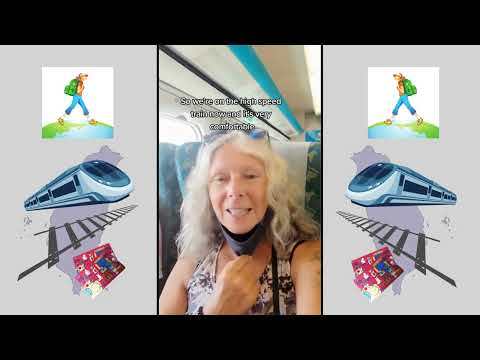
Trains and travel in Taiwan using Easy Card
The Easy Card is not just for ease of payment on local transportation in Taiwan. You can also use your Easy Card to swipe a payment for goods in local convenience stores like 7-11 Stores and Family Marts (where you can also top up your Easy Card).
You can also use it to pay for coffee at Starbucks!
HOW LONG DOES TAIWAN EASY CARD LAST?Your Easy card does not expire as it is a ‘pay as you go’ card. Although, you would have to reactivate it, if you haven’t used it for over a year. Regarding the SIM packages: you can choose how long your SIM is active to suit your planned stay in Taiwan.
SIM packages are avalable at prices for Unlimited Data and credit for calls at either 5,7,10 or 15 days.
 Klook.com (function (d, sc, u) { var s = d.createElement(sc), p = d.getElementsByTagName(sc)[0]; s.type = "text/javascript"; s.async = true; s.src = u; p.parentNode.insertBefore(s, p); })( document, "script", "https://affiliate.klook.com/widget/fe..." );DO I NEED A SIM CARD IN TAIWAN?
Klook.com (function (d, sc, u) { var s = d.createElement(sc), p = d.getElementsByTagName(sc)[0]; s.type = "text/javascript"; s.async = true; s.src = u; p.parentNode.insertBefore(s, p); })( document, "script", "https://affiliate.klook.com/widget/fe..." );DO I NEED A SIM CARD IN TAIWAN?SIM Package: Our choice of package gives us a local SIM for our phones with 10 days unlimited Wi-Fi data and 100 TWD for any calls we might make.
In every country I visit, I feel it’s important to have Wi-Fi on my phone.
I find it especially useful when I’m out and about in cities for using Google Maps, finding directions, looking up places to eat and drink, and maybe ordering a Grab taxi.
DO I NEED A SEPERATE TICKET FOR THSR TRAIN TRAVEL?
THSR Discounted Tourist Ticket (ticket for non-Taiwanese): Do note that you can’t use your Easy Card on the intercity Taiwan High Speed Rail (THSR) ‘bullet trains’ so you’ll need to purchase a ticket separately.
OUR TAIWAN ITINERARY AND TRAVEL PLANS
From Taoyuan International Airport, using our Easy Card to swipe and pay, we took the airport express train to Taipei Main Station.
At Taipei Main Station, using our THSR Discounted Tourist Ticket, we took a southbound THSR Bullet Train down to the mid-point city of Taichung.
Do read my post on our Taiwan High Speed Rail ‘Bullet Train’ experience.
Our itinerary would also mean taking an intercity bullet train between Taichung and the south coast city of Kaohsiung. Then for the return journey to Taipei.
But within the cities we would exclusively use our Easy Cards to travel around using the local trains, local busses, and even the ferry over to Cijin Island.
TRAVEL TIP FOR TAIWANMy BIG TRAVEL TIP for you is to arrange your Easy Card, your SIM Card, and your intercity THSR Discounted Tourist Ticket, all ahead of travel.
You’ll get a voucher from Klook for your online purchases and clear instructions for an easy and convenient airport pickup at the KLOOK KIOSK in the arrivals hall.
This will all make travelling around Taiwan not only easier but more fun and more affordable too.
I hope this article has been helpful to you.
Klook.com (function (d, sc, u) { var s = d.createElement(sc), p = d.getElementsByTagName(sc)[0]; s.type = "text/javascript"; s.async = true; s.src = u; p.parentNode.insertBefore(s, p); })( document, "script", "https://affiliate.klook.com/widget/fe..." );Let me know in the comments or get in touch.
Check out all my posts on Taiwan.
Are you planning a trip to Taiwan?
To what cities in Taiwan will you travel?
Will you be using the THSR Bullet train?
I RECOMMEND WN TRAVEL INSURANCE – GET A NO OBLIGATION QUOTE TODAY!

The post Taiwan: Do I Need An Easy Card? appeared first on The Backpacking Housewife.
January 2, 2024
Taiwan Travel – Taiwan High-Speed Rail (THSR)
Having recently experienced travel on a bullet train before in both South Korea and Japan, I was excited to travel on the Taiwan High-Speed Rail (THSR).
The Taiwanese bullet train travels at speeds up to 300 km/hr (186 miles/hr) and the high-speed route runs along the western coast of Taiwan connecting the capital city Taipei with all the major cities in Taiwan.
We’d arrived at Taiwan’s Taoyuan International Airport in the early morning.
Our first mission was to collect our Easy Cards and phone SIMs package from (affiliate link) the Klook Office that we’d pre-ordered to make our travelling around Taiwan on various means of transport an easy one-swipe task.
Find out more from Kook about Easy Cards and THSR Tourist Rail Passes.
Klook.com (function (d, sc, u) { var s = d.createElement(sc), p = d.getElementsByTagName(sc)[0]; s.type = "text/javascript"; s.async = true; s.src = u; p.parentNode.insertBefore(s, p); })( document, "script", "https://affiliate.klook.com/widget/fe..." );Our planned itinerary for Taiwan meant that on arrival we were looking to travel from Taipei Airport to city on the Airport MRT Express Train to Taipei Main Station (journey time 40 mins).
Then from Taipei Main Station we’d take a THSR ‘bullet train’ south from Taipei (journey time 1 hour) to explore the island’s midpoint city of Taichung for a few days.
There are three types of THSR tickets available: business car, standard car and non-reserved car.
Business and standard tickets both have reserved seats.
Find out about THSR Taiwan bullet train timetable and also using the Klook links I recommend.
 Click to Read my 12 Day Guide & ItineraryTHSR TAIWAN BULLET TRAIN TIMETABLE
Click to Read my 12 Day Guide & ItineraryTHSR TAIWAN BULLET TRAIN TIMETABLEAfter exploring Taichung, we were planning on continuing travelling on to the southern tip of Taiwan and the port city of Kaohsiung, again for a few days.
Then, we’d return to Taipei on the northern THSR bullet train along the entire route this time (journey time 2 hrs 20mins) just in time for The Lantern Festival!
It’s comforting to note that in Taiwan there are only two THSR lines – northbound and southbound – so it’s very hard to get it wrong.
You simply need to make sure you choose the right direction before boarding!
Find out more about THSR Taiwan bullet train timetable and tickets.

THSR TAIWAN BULLET TRAIN ROUTE
Along the high speed rail networks route there are twelve THSR stations: From the northern tip: Nangang, Taipei, Banqiao, Taoyuan, Hsinchu, Miaoli, Taichung, Changhua, Yunlin, Chiayi, Tainan and Zuoying at the furthest southern tip of Taiwan.
All these stations are well connected to all other modes of transportation like the local trains and those on the standard metro network as well as buses.
This makes Taiwan one of the easiest, most energy efficient, cost effective, and most environmental viable counties on which to travel on public transport.
The trains are also a pleasure to ride because not only are they fast and efficient and always on time, they are comfortable with aircraft style seats, spotlessly clean, and with services such as Wi-Fi, power outlets, and food and beverage options onboard.
As for the term bullet train, it is often used as a generic term to describe high-speed trains with a streamlined design, particularly those that resemble the iconic Shinkansen trains of Japan.
Interestingly, the Taiwan trains also utilises Japanese Shinkansen technology, however, they are built to European safety standards and adapted to Taiwan’s climate.
 Taiwan High Speed Rail – Bullet TrainTHSR INTERESTING FACTS
Taiwan High Speed Rail – Bullet TrainTHSR INTERESTING FACTSTHSR opened on January 5 2007.
THSR is the shortest high-speed train route in the world.
The length of the THSR route is 345 km/214 miles.
Each high-speed train travels with 12 soundproofed cars.
On route there are 48 tunnels. The longest is 7.36 km/4.6 miles.
The THSR train passes through 14 cities and 77 towns.
THSR is the longest continuously elevated railway in the world as just 9% of the track was built on the ground.
Total cost of construction so far is around 14.5 billion US$.
Are you planning a trip to Taiwan?
Or have you already been?
Let me know if you’ve found my posts helpful?
Leave a comment or get in touch!

The post Taiwan Travel – Taiwan High-Speed Rail (THSR) appeared first on The Backpacking Housewife.
Taiwan – A Travel Guide
I was yawning and struggling to keep my eyes open as our flight descended into Taiwan.
It was our second delayed flight of the day/night and we had been scheduled to arrive in Taipei’s Taoyuan airport at around midnight. Now, it was early morning.
We’d have long missed the bullet train we’d booked to take us halfway down the Taiwanese coastline to the city of Taichung.
We’d have to re-ticket as well as pick up our tourist Easy Transit Cards and phone SIMs.
And then, from my window seat, something amazing happened.
My eyes grew wide and my breath became a gasp as a bright burnt-orange ball of light emerged from the dark sleepy mountainous backbone of Taiwan.
And I was suddenly enormously grateful for all our delays.
Because without them it wouldn’t have been possible to receive this gift.
The gift of seeing sunrise over Taiwan.
 First light over TaiwanTaiwan – A Travel Guide
First light over TaiwanTaiwan – A Travel GuideI love travelling in Asia and I’d been curious about travel to Taiwan for a while.
To me, Taiwan, as a tourist destination, still felt kind of new and unexplored compared to – for example – the popularity of Japan and South Korea.
I recognised it as somewhere kind of unique and it was definitely on my radar.
But, it wasn’t until the island’s disputed connection to China became recent news, that I decided I needed to go there sooner rather than later.
Taiwan is a country in East Asia officially known as the Republic of China (ROC) except that Taiwan has been governed independently of China since 1949. To understand the complicated current politics BBC News have a simple guide.
China And Taiwan – A Really Simple Guide
I am not at all interested in politics. But I’d felt the same way about visiting Hong Kong.
Also, while travelling this past year, on two separate occasions, I’d happened to meet and get to know some lovely people from Taiwan and I’d really enjoyed talking with them and asking about their country.
I wanted to know which city they were from (Taichung and Kaohsiung) and where we should go and what should we see as tourists in Taiwan.
And how long should we plan to stay?
It doesn’t look that big on the map to me so maybe we could do a week after our trip to South Korea in a couple of months’ time?
Chatting to my new Taiwanese friends, it was quickly established that one week wasn’t going to cut it.
Not if the backpacking husband and I wanted to travel along the length of the island while stopping off to explore all the sights along the way.
I was told we must see the majestic mountains, the national parks and lakes and experience the Taiwanese culture, the museums and markets and temples. We must sample the tea houses and the amazing food.
Taiwanese cuisine is a magical meld of Chinese and Japanese influences.
Taiwan is renowned, I’m told on great authority, for its street markets and Michelin Star street food!
And I loved the sound of it all.
I also loved the enthusiasm and warm affection with which my new friends spoke of their home country.
Then to top it all, it was mentioned that should we travel to Taiwan in February on the 15th day of the first lunar month, then The Taiwan Lantern Festival was being held in Taipei, for the very first time in twenty-three years.
This year’s theme was to celebrate the Year of The Rabbit and the festival was completely FREE to attend.
You can find out more about the next Taiwan Lantern Festival on the Taiwan Tourism Website.
I immediately began planning a trip to Taiwan in early February – before our planned trip to South Korea.
Our itinerary would include travelling down the coast on a bullet train and stopping off at all the cities and places we wanted to see long the way before heading back to the capital city of Taipei in time to experience the The Lantern Festival.
Wow. What an amazing trip!
So please do join me on a fabulous travel adventure where we get to spend twelve days/ten nights exploring Taiwan!
TAIWAN – A TRAVEL GUIDE Taiwan’s High Speed ‘Bullet’ Trains
Taiwan’s High Speed ‘Bullet’ TrainsTHSR BULLET TRAIN: First off, let’s experience train travel using the Taiwan High Speed Rail (THSR). The Taiwanese 300kph ‘bullet train’ can take you the length of the island’s west coast from Taipei to Kaohsiung in just one day.
IN THIS TAIWAN TRAVEL GUIDE: We travel south through to Taichung City, where we stay for three nights before moving further south to the port city of Kaohsiung for another three nights. After that we took the train all the way up north and back to Taipei for a four nights stay – just in time for The Lantern Festival.
EASY CARD: In this post, I talk about the prepaid tourist transport card. Watch my video explaining how the Easy Card works and how to get one. I’ll also show you how easy it is to travel independently and safely (it’s one of the safest countries in the world) around Taiwan with helpful links to transport services.
TAICHUNG CITY ITINERARYTAICHUNG CITY: There is SO much to see and do in Taiwan’s second largest city.

Good morning Taiwan!
CHUN SHUI TANG: The original tea shop that invested the now world-famous Bubble or ‘Pearl’ Tea.
TAICHUNG PARK: Join me for a morning walk around the lake in the oldest park in Taichung City.
THE EARTHQUAKE MUSEUM: Find out about the 1999 earthquake and the engineering practices that can now make tall buildings earthquake proof.
FENG CHAI NIGHT MARKET: Come with us to experience the famous Night Market in Taichung!

Taichung: Feng Chai Night MarketKAOHSIUNG CITY ITINERARY
KAOHSIUNG CITY: This large port city in the southern bay of Taiwan sits on the Love River with its romantic waterfront park.
THE DOME OF LIGHT: The city also boasts a unique light show, with the world’s largest public art installation made from individual pieces of coloured glass, with ‘The Dome of Light’ being a feature of the Formosa Boulevard MRT Station in Kaohsiung.
CIJIN ISLAND: Join us on a day trip from Kaohsiung by ferry over to tiny Cijin Island.
LIUHE NIGHT MARKET: And, of course, in Kaohsiung, we couldn’t miss the Liuhe Night Market!
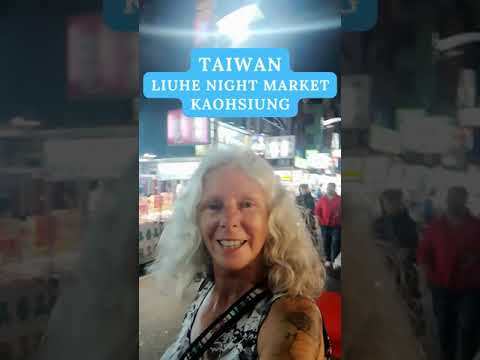
Kaohsiung: Liuhe Night MarketTAIPEI ITINERARY
TAIPEI: We travelled back up to Taipei on the bullet train directly from Kaohsiung. We stayed for four nights in the city centre and explored using the metro trains, buses, and by doing lots of walking.
ELEPHANT MOUNTAIN: Also, it was wonderful to take a leisurely hike out to Elephant Mountain for a fantastic view of Taipei City.
TAIPEI 101 TOWER: An absolute highlight was visiting the Taipei 101 Tower which was the world’s tallest building when it first opened in 2004. During the Lantern Festival, seeing The Taipei 101 Tower lit up and animated with bouncing pink rabbits in keeping with the theme of The Year of The Rabbit was also a spectacular sight!
MICHELIN STAR STREET FOOD: In this post, come with us on a food fest in search of Michelin starred street food at the biggest and most famous street food market in Taiwan – The Shilin Market!
THE LANTERN FESTIVAL: The main event was, of course, the Lantern Festival. Don’t miss this post in which we perused the event park in the daytime and then went back after dark to experience the full light show extravaganza!
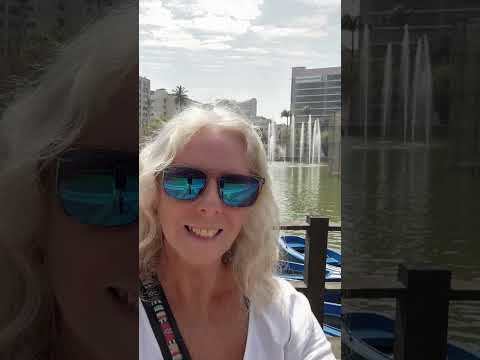
Highlights of Taiwan – A Fabulous 12 Day Itinerary!
JOIN ME FOR 12 DAYS/10 NIGHTS IN TAIWAN
Have you ever travelled to Taiwan?
If not, is Taiwan on your travel radar?
I hope you’ll go on to read all my Taiwan travel guides!
If you’ve found them helpful do let me know in the comments!
The post Taiwan – A Travel Guide appeared first on The Backpacking Housewife.
January 1, 2024
Ten Years of Nomadic World Travel
This month, January 2024, the backpacking husband and I are looking back on ten years of nomadic world travel and we’re amazed at how fast a whole decade has flown by!
Ten years ago, in January 2014, we’d just enjoyed a wonderful Scottish family Christmas with our three grown up sons.
Then, having already sold the house and everything else we owned – our cars, our furniture, all our belongings – we moved out of what was then an empty-nest.
I remember, back then, we were both in our mid 50’s with a vague ‘ten-year plan’ and a mutual wanderlust.
We had decided to go off and explore the world as nomads and have lots of travel adventures.
Because if not now… when?
 We’d decided to go off and explore the world as nomads and have travel adventures.
We’d decided to go off and explore the world as nomads and have travel adventures.And now what? After ten years of travel and adventure? What’s for the future?
Actually, we’ve no idea. But we do know that still want to continue to travel for as long as is possible!
Exploring new countries and returning to places we love has become a way of life for us.
I suppose, the two years we were grounded due to the pandemic – when we returned to Scotland to rent a house – only validated what we already knew. A nomadic lifestyle suits us perfectly fine!
Ten years on and we’re now travelling in our mid-60’s.
Although, we ‘ve noticed travel is certainly more exhausting than it was when we were in our mid-50s.
 Ten years on and we’re now travelling in our mid-60s
Ten years on and we’re now travelling in our mid-60sThe hours spent in airports takes its toll and jet lag and travel fatigue takes longer to get over.
So, we’ve learned a few things over the past ten years.
We’ve learned to travel slowly and whenever possible stay in places for longer.
And now, in 2024, I see that’s becoming trendy.
Would you believe travelling slowly as a nomad is called ‘slomading’?
I thought I’d write this post in timely celebration of the past ten years.
To answer a few questions we often get asked about how we travel and what happens next?
All questions I might actually know the answers to now – after ten whole years of travelling around the world – as an ex-housewife, a travel writer, a writer of romantic adventure novels and a slomad.
TEN YEARS OF NOMADIC WORLD TRAVEL – WHERE HAVE WE BEEN?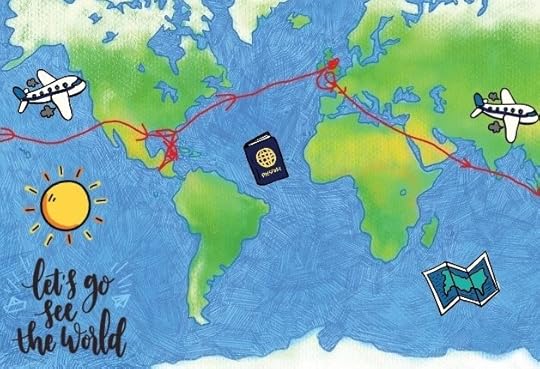 Let’s Go See The World
Let’s Go See The WorldTen years ago, we set off on a quest to explore the islands of The Caribbean and we found one we loved best.
It’s a tiny paradise island just off the coast of Honduras in the Caribbean Sea called Utila.
The smallest of the Islas de la Bahia – The Bay Islands.
We’ve been back there many times since and often stay for either three or six months at a time.
I just did a quick calculation and our visits have amounted to two whole years spent on the island!
When we’re on Utila, the backpacking husband is scuba diving. He started his dive training there in 2014.
 On the Caribbean Island of Utila
On the Caribbean Island of Utila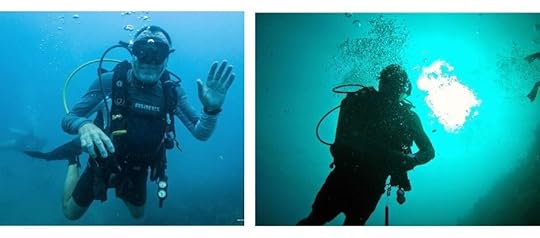 The backpacking husband loved to go scuba diving
The backpacking husband loved to go scuba divingWhile he’s diving, I’m busy writing or editing, or spending time with my island friends at the beach.
While on route to the Caribbean, we have explored lots of Mexico, North America, Canada, and Central America.
We’ve spent a lot of time travelling in Asia too. Specifically, Thailand and Malaysia and Vietnam.
In Thailand, again over many visits, we spent a lot of time on Koh Tao – and island in the Gulf of Thailand.
The backpacking husband did his Dive Instructor Training and his IDC Staff Instructor course on Koh Tao at Bans Dive Resort.
Altogether, I guess we must have spent at least two years in Thailand, over the past ten years.
We’ve also explored parts of China, Indonesia, Philippines, Cambodia, and in the springtime of this year we spend a total of a month touring Taiwan and Japan.
When we’re based in Asia, we get to visit our middle son and his family. We have a darling grandson in South Korea.
Right now, we’re housesitting in France. We’ve done this many times now and mostly at the same property in southwest France – The Dordogne – which feels like Scotland to me only in sunshine!
It was while I was housesitting that I wrote The Backpacking Housewife series of books published by HarperCollins.
 The link here is affiliated and takes you to my book page on Amazon
The link here is affiliated and takes you to my book page on Amazon
Again, if I add up all the months we’ve been housesitting, that also comes in at around two years.
Housesitting is when you arrange to look after someone’s home and pets (if they have them) while they are away and in exchange you get to live in their house rent free.
I’ve written a post about housesitting. How we do it to live like a local – and how you can do it too if you’re curious.
We did, of course, also spend the two years of 2020 and 2021 grounded by the pandemic.
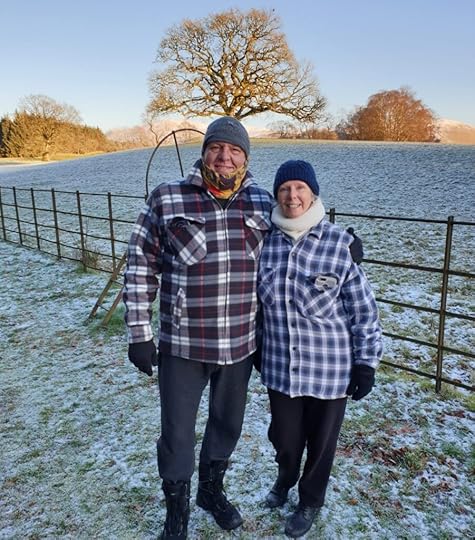 We spent the pandemic years – 2020 and 2021 – in Scotland
We spent the pandemic years – 2020 and 2021 – in ScotlandIn early March 2020, we were in London at the airport waiting to board a trans-Atlantic flight, when all flights were suddenly cancelled.
Somehow, in the panic and chaos, we got our heads together and made some phone calls.
We are so fortunate to have had a friend with an empty holiday cottage in Scotland to rent to us.
So, that means, that in ten years we have been travelling as nomadic slomads we’ve spent:
Two years in the Caribbean: Two years in Thailand:
Two years in France. Two years in Scotland.
That actually leaves just two years for exploring the rest of the world.
And, those two years include our visits to South Korea and our occasional trips back to the UK.
TEN YEARS OF NOMADIC WORLD TRAVEL – HOW DO WE TRAVEL?We travel slowly and we travel light.
We don’t own anything except for what we can each carry in a cabin bag and small backpack.
This past year, in fact, we travelled with only 7kg of hand luggage all around Asia.
Although, that time, the backpacking husband did leave all his heavy dive gear back in the Caribbean!
We didn’t start out travelling light! In 2014, we headed off with a whole load of travel gadgets and a heap of luggage!
I can hardly believe it now. Good grief… what on earth was in all those suitcases and backpacks?
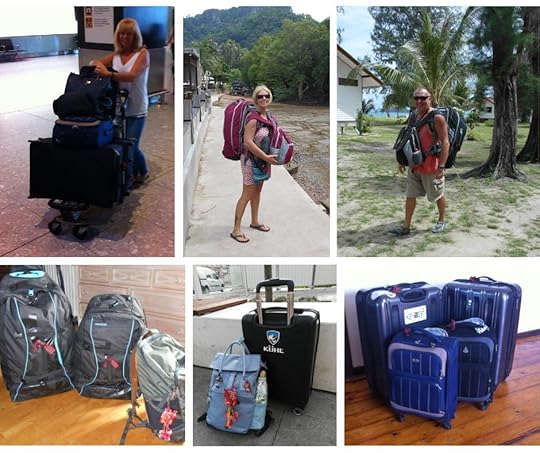 Thankfully, we have now reduced our luggage to hand luggage only!
Thankfully, we have now reduced our luggage to hand luggage only!We’ve certainly evolved over these past ten years and realised that a person really doesn’t need a lot of luggage to live well.
And, if you are like me – you’ll just wear the same few outfits over and over – anyway!
Thankfully, we gradually reduced our luggage from huge suitcases to large backpacks and then then to wheeled bags and now we’re at hand luggage only. I wrote a post on the merits of backpacks verses suitcases that you might find useful!
It’s such a relief not to haul so much stuff around and its cheaper too.
When we travel with hand luggage on budget flights – which we often do – we don’t have to pay to check bags.
If you are wondering what it feels like to not own anything of any material value, I can tell you, it feels like freedom.
Because, with no possessions, life feels uncluttered.
With no belongings, you can focus on living and experiencing and, importantly, being spontaneous.
TEN YEARS OF TRAVEL – WHERE DO WE STAY?It’s true that we have slept in countless beds over the past ten years.
It’s also true that some are more comfortable than others.
If we stay anywhere longer than a couple of weeks, we will rent a house or an apartment.
If we stay a week or two, we usually stay in a small guesthouse or a homestay.
If it’s just for a few nights, then we might book a private room in a hostel or a budget hotel.
Or we might even splurge on a fancy hotel. We’ll often save up hotel points to earn an ‘upgrade’.
We mix up budget travel with a bit of luxury occasionally, especially if we are celebrating a birthday or an anniversary.
The backpacking husband and I celebrated our 40th wedding anniversary this year and we went to the Maldives.
It was a short and inexpensive flight for us to get to Male (Maldives) as we were already in Asia.
 The backpacking husband and I celebrated our 40th wedding anniversary this year
The backpacking husband and I celebrated our 40th wedding anniversary this yearAs I already mentioned, we also do quite a bit of housesitting in between travels.
And that’s where we are right now – we’re in France (again) – on a fabulous housesit.
TEN YEARS OF TRAVEL – DO I MISS ANYTHING FROM OUR PREVIOUS LIFE?Yes, I miss family and friends. But we do have family and friends all over the world.
I miss my mum and my siblings and our friends back in the UK. But we all keep in touch.
Being transient and missing people is actually a big downside to this nomadic life.
Our three sons are all aged in their 30’s now and they have family and careers and busy lives.
So, I don’t expect we’d see them all the time, even if we lived just around the corner from them.
Our eldest and his family – we have two darling twin granddaughters – live in Edinburgh Scotland.
The middle son and family – as I mentioned earlier – live in South Korea.
Our youngest and his fiancé live in England UK.
But we are in touch all the time using the internet. We have a family WhatsApp group so we message and post jokes and videos. The best thing is when we do see each other we spend quality time together.
Friends and family have on many occasions travelled to be with us in places around the world.
We do also get to visit family who live in other countries too. All my cousins live in Canada.
 Whistler Mountain: While visiting family in CanadaTEN YEARS OF TRAVEL – SOMETIMES IT’S THE LITTLE THINGS
Whistler Mountain: While visiting family in CanadaTEN YEARS OF TRAVEL – SOMETIMES IT’S THE LITTLE THINGSI’m sometimes asked what it’s like when things go wrong while travelling. What if we get sick, stuck, or tired?
Yes, we sometimes have to deal with frustrations but life is always an adventure.
We’ve experienced delays and exhaustion and occasional sickness or injury, but luckily, it’s all worked out.
It’s true that its not good all the time. Sometimes I feel upset at the little nuisances of travelling life.
Like having to throw a favourite item away simply because I don’t have room for it in my bag anymore.
I occasionally get frustrated at airport rules about what I can carry in my cabin bag.
I can never carry a favourite product in anything larger than 100ml. I appreciate it’s for safety.
But I’ve lost count of how many pointed nail scissors I’ve bought and had confiscated.
And, not having a winter coat or shoes, if we find ourselves suddenly in a cold climate coming from a hot one.
It’s also absolutely no fun shivering in summer clothes and flip flops when it is snowing!
 Facebook Update: Leaving a housesit in France and travelling lightTEN YEARS OF TRAVEL – NO REGRETS
Facebook Update: Leaving a housesit in France and travelling lightTEN YEARS OF TRAVEL – NO REGRETSWe can honestly say that in ten years of nomadic world travel we have no regrets and only the greatest travel experiences.
I personally get through tough times and uncertainty by simply having faith that things will work out.
And, usually, somehow, they do!
I do, of course, also realise that freedom comes at a price and that travel is always a privilege.
We fully accept there are compromises to be made and there are uncertainties in the life we’ve chosen.
TEN YEARS OF TRAVEL – WHAT HAPPENS WHEN WE STOP?There is, of course, the inevitable scenario that one day we will have to stop or curb nomadic world travel.
Then we will have to face the questions: Where will we live? What will we do? How will we feel?
Something might happen to prevent us from travelling (as did the Covid Pandemic) and then we’d need to find somewhere to settle down.
What happens when we get too old or too frail to travel?
Again, I simply have faith that things will always work out.
And, a really important question, is how will we feel once we can’t travel anymore?
We’ll hopefully have all our memories and fabulous stories to tell.
And, we’ll be very grateful and thankful and I’ll say, thank goodness we travelled the world (we’re currently on our third slow circumnavigation) when we were still young enough and fit enough to do it and while we had the resources to fund it.




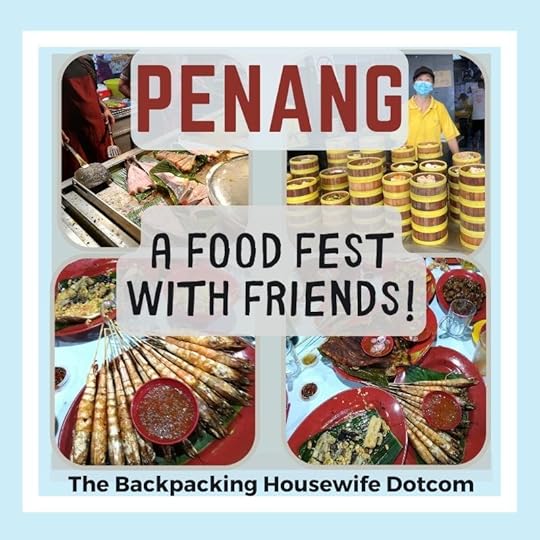 Click on the images to see the travel post
Click on the images to see the travel post

We are definitely SKI’s – Spending The Kids Inheritance – but I’m sure they don’t mind.
Our boys are happy and successful in their own right and independent by their own means.
So, they don’t need us right now.
I believe that’s what good parenting is all about. Helping them to grow their wings.
So we can all eventually – if we feel that life is meant to be lived in more than one place – fly the empty nest too.
WHAT HAVE I LEARNED IN THE PAST TEN YEARS OF TRAVEL?I’ve learned that the world is incredibly beautiful and precious and fragile place.
I’ve learned a lot about sea turtles by volunteering at a turtle sanctuary on a tiny island off Malaysia.
I’ve learned about Orangutan conservation from seeing them in the wild in Borneo.
I’ve seen with my own eyes the most amazing sights and experienced the most beautiful places.

 Click on the images to see the travel post
Click on the images to see the travel post

Thanks to modern day technology, the world seems smaller than it once was, as it’s now possible to travel across the whole world in just one day.
Did you know that time travel is possible? We travelled from Beijing China across the Pacific Ocean and the international dateline and actually arrived in San Francisco before the time we left Beijing.
I know from experience of travel that people of the world are more similar than they are different.
That strangers are just friends you haven’t met yet.
And, despite what the TV news might have you believe, most places are not as dangerous as they are portrayed in the media. Most people in the world are in fact good and kind and generous.
I hope you’ve enjoyed my post and my photos from our past ten years of nomadic world travel.
I also hope you’ll follow the highlighted text in this post to be inspired by our nomadic world travel destinations and experiences.
Please do bookmark and pop back to my website as I’m adding new travel posts all the time.
If you sign up to my mailing list you’ll receive my personal newsletter at the start of each month.
I promise I’ll never spam you and you can, of course, easily unsubscribe whenever you like.
From here in France, I want to wish you, wherever you are in the world, a very happy 2024.
I hope this New Year brings us all health and happiness and worldwide peace.
Janice xx
The post Ten Years of Nomadic World Travel appeared first on The Backpacking Housewife.
December 29, 2023
Borneo’s Wild Orangutans
Our visit to the Sepilok Orangutan Rehabilitation Centre and seeing Borneo’s Wild Orangutans was an experience of a lifetime.
We flew from Kota Kinabalu to Sandakan in the Sabah region of Borneo and headed to The Sepilok Orangutan Rehabilitation Centre – the precious home of the last wild Orangutans of North Borneo.
The centre, in 43 square kilometres of virgin equatorial rainforest, was set up in 1964 by an English woman called Barbara Harrison.
It was the first centre in the world to dedicate itself to the rehabilitation of orphaned Orangutans, caught illegally or kept as pets or displaced as a result of illegal logging and deforestation.
Medical care is also provided to those who have been injured.
When we visited, around sixty to eighty Orangutans were living independently in the rainforest reserve and approximately twenty-five orphaned Orangutans were being housed and cared for in the nursery.
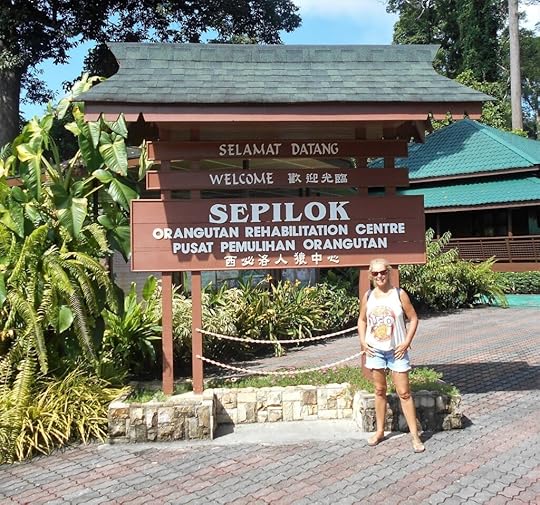 Our visit to the Sepilok Orangutan Rehabilitation Centre and seeing Orangutans in the wild was an experience of a lifetime
Our visit to the Sepilok Orangutan Rehabilitation Centre and seeing Orangutans in the wild was an experience of a lifetimeToday, as well as caring for young orphaned Orangutans, it looks after dozens of other wildlife species too, including Sun Bears, Gibbons, Sumatran Rhinos, and Borneo Pygmy Elephants.
 The centre looks after Sun Bears and other wildlife too.Borneo’s Wild Orangutans
The centre looks after Sun Bears and other wildlife too.Borneo’s Wild OrangutansAfter our arrival at Sepilok, we bought our entrance tickets and watched an introductory video presentation, explaining the crucial work being done to rehabilitate orphaned Orangutans.
The video by the Orangutan Appeal UK presentation is highly emotional.
Then, walking through dense Borneo jungle, along managed trails and elevated wooden gantry pathways and bridges to keep us above ground level and safe from snakes and other dangers, we made our way to the feeding stations.
 We made our way through dense Borneo jungle along managed trails.
We made our way through dense Borneo jungle along managed trails.The Orangutans are provided with supplementary food which is given to them daily at 10am and 3pm.
But you should know that this additional food is purposefully designed to be bland and boring to encourage the young apes to forage for tastier food for themselves in the forest.
Along the way we managed to spot some pigmy elephants.
All around us the trees were so incredibly ancient and tall and it was a fabulous experience to see both young and older Orangutans swinging through the tree canopy above us towards the food station.
My photos really didn’t do our experience here justice but then being behind the camera wasn’t the point of being here, so for once, I didn’t take many snaps. I just stood in awe and wonder as these beautiful Orangutans sat and ate or swung on ropes or through the trees around me.
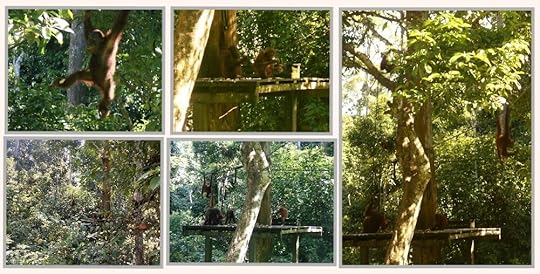 Sorry… my photos at the feeding station really didn’t do our experience justice!
Sorry… my photos at the feeding station really didn’t do our experience justice!The word Orang-Utan means ‘Man of the Forest’.
Sightings at the feeding station are not guaranteed but we were fortunate in seeing lots of Orangutans on that day.
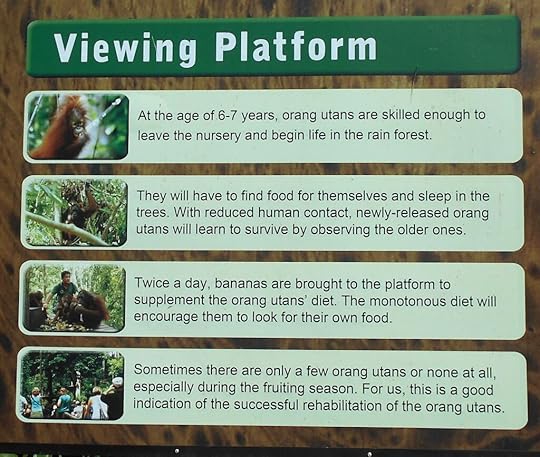
On the Sepilok Centre website it states: “The orangutans that come for this free feed are wild and therefore can be dangerous, so there are staff on hand to make sure interactions do not occur, for the safety of both visitor and orangutan.
Because they are wild, it can never be guaranteed that many will come for the feed, if any at all (especially during the fruiting season). This is where some people leave disappointed, but the truth is if no orangutans come, then it is a positive thing – it means they are not reliant upon the feeding to survive.”
The whole experience was amazing.
Afterwards, we went to visit the outdoor nursery to observe the juvenile orangutans on their final stage of rehabilitation before release.
We also watched the more advanced Orangutans in the outdoor nursery, eating and developing their confidence by play and using the ropes provided.
In the outdoor area, they also have access to the forest in preparation for the day that they desire to explore further and join their wild friends and family.
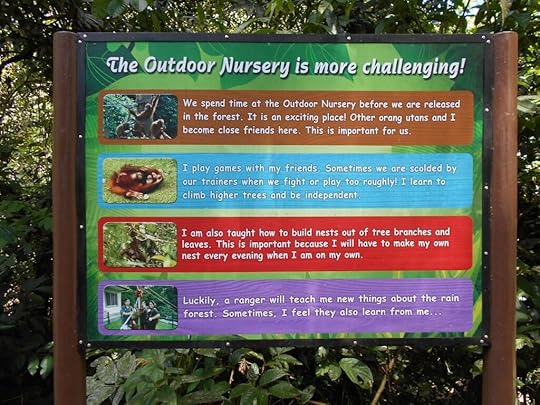


AMAZING THINGS ABOUT ORANGUTANS
 Orangutan mother and baby
Orangutan mother and babyThere are only two species of Orangutan in the word: the Borneo Orangutan and the Sumatran Orangutan.
The Orangutan is the only great ape outside Africa.
97% of our DNA is identical to that of the Orangutan.
The Orangutan has the longest childhood dependence on the mother of any wild animal in the world.
The Orangutan is strictly arboreal – it lives exclusively in the trees – making it the largest tree living mammal in the world.
Established in 1964, Sepilok was the first centre in the world to dedicate itself to the rehabilitation of orangutans.
The Sepilok Orangutan Rehabilitation Centre is owned and run by the Sabah Wildlife Department, from which it receives some funds.
The charity Orangutan Appeal UK funds projects at the centre including the renovation of enclosures and equipment, as well as funding five members of the care team, including a veterinary nurse.
Additional funding comes from the entrance fee charged to tourists and from Orangutan adoption.
It’s important to note that despite the success stories, the conservation status of Bornean orangutans is precarious, and managed ongoing efforts are essential to ensure their survival in the face of various threats.
Our visit to the Sepilok Orangutan Rehabilitation Centre and seeing wild Orangutans living in the rainforest and jungles of Northern Borneo was an experience of a lifetime and one I will always cherish.
WHERE DID WE STAY?In Sandakan, we stayed in a Standard Double Room with breakfast included at (affiliated link) Nature Lodge Sepilok for two nights and we booked with Booking Dotcom.
Have you ever experienced seeing Orangutans in the wild?
Is seeing Orangutans in Borneo on your travel wish list?
Let me know! I’d love to hear from you.

THE BACKPACKING HOUSEWIFE RECOMMENDS TRAVEL INSURANCE
The post Borneo’s Wild Orangutans appeared first on The Backpacking Housewife.


